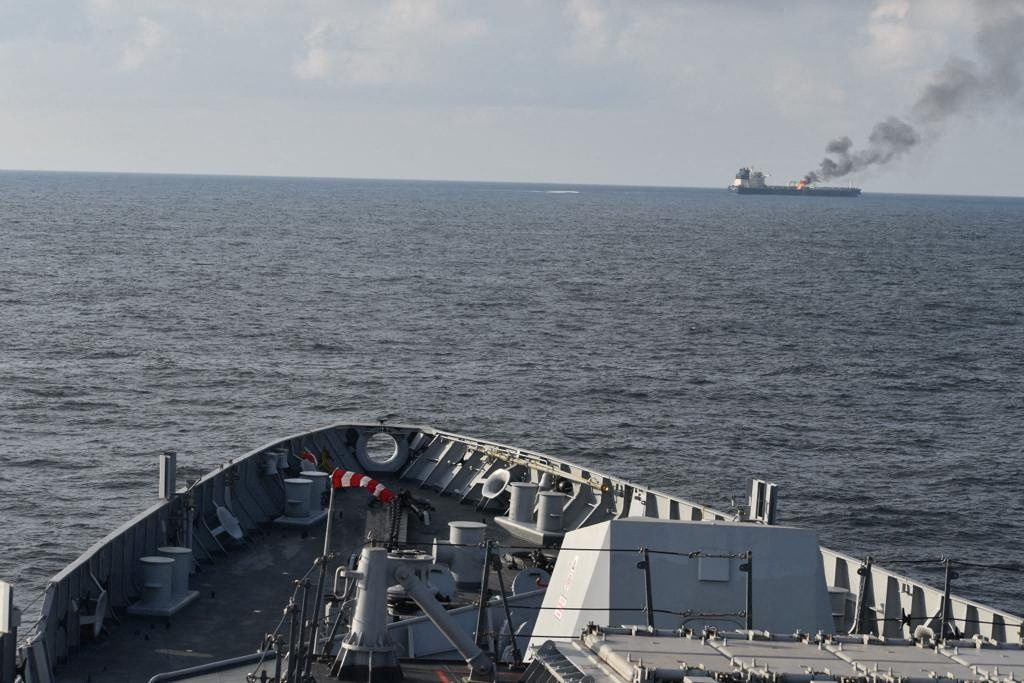Ukraine Hits Third Russia Shadow Fleet Tanker in Black Sea
Ukraine has carried out a third sea drone attack on a Russian shadow fleet tanker in the Black Sea, marking an escalation in Kyiv’s campaign to disrupt Moscow’s maritime oil...


SINGAPORE, Feb 21 (Reuters) – The use of anti-ship ballistic missiles (ASBMs) in the Red Sea has spurred interest in Asia about the systems used to shoot them down, experts and industry officials say – although China, with its huge ASBM arsenal, presents a tougher challenge.
U.S. Central Command (CENTCOM) media releases from Nov. 27 – the world’s first documented use of an ASBM in combat – to Feb. 20 mention a total of 48 ASBMs and 12 interceptions in the Red Sea. Those releases noted that many ASBMs fired by the Iran-aligned Yemeni Houthis posed no danger and were not engaged.
On the sidelines of the Singapore Airshow this week, a senior executive at a U.S. defense contractor said the air defense activity in the Red Sea and in Ukraine had caught the attention of potential customers in Asia.
“What we’re seeing is demand increase for integrated air and missile defense here,” said the executive, who declined to be named because of the sensitivity of the matter. He said that included sensors to detect targets, the weapons to shoot them down and the command-and-control systems tying it all together.
Robert Hewson of Sweden’s Saab SAABb.STsaid at the air show that customers in Asia were now more interested in not just countering ballistic missiles, but also small, “low-end” aerial threats such as drones that have been launched in concert with larger attacks in the Red Sea.
“It turns out we can do this ballistic missile stuff,” Hewson said. “It costs a lot of money and shoots big expensive missiles, but it looks like it all works. What we’re not really able to do reliably is handle swarms of small threats that are coming at us … at the same time.”
CENTCOM said it did not have a complete tally of ASBMs fired, interceptions and interception attempts for public release. A U.S. defense official said whenever ASBMs were in range of a Navy ship, they were engaged.
U.S. Navy destroyers are equipped with the Aegis air defense system, with components from Lockheed Martin, among others, which is designed to shoot down aircraft, cruise missiles and ballistic missiles.
Aegis uses RTX subsidiary Raytheon’s SM-2, SM-3 and SM-6 missiles to intercept threats. A Raytheon spokesperson declined to comment on whether the company had seen increased interest in missile defense systems since the Houthi attacks began. A Lockheed Martin spokesperson provided public information about increased production of certain systems.
A spokesperson for European defense conglomerate MBDA noted at the air show that the British government had awarded it a 400 million pound ($505 million) contract in January to upgrade its Sea Viper air defense system to handle ballistic missiles.
A missile defense program director with direct knowledge of the Aegis system said a key takeaway from that conflict was missile defense ships must have “deep magazines,” carrying enough interceptors to allow multiple shots at each threat.
U.S. Navy Admiral Mark Melson, commander of Logistics Group Western Pacific, said at the air show the military was studying what lessons from the missile engagements could be applied in Asia and elsewhere.
“In a very competitive shipping environment, where we potentially have a scenario where weapons are getting used as a high rate, clearly, we want to understand what that sustainment challenge looks like,” he said, speaking about keeping U.S. warships’ missile defenses supplied.
The Houthis have said all their missiles are domestically produced. Experts, the U.S. military and the U.S. Defense Intelligence Agency say Iran has at least provided assistance, if not weapons themselves.
In either case, the ASBMs and targeting on display in the Red Sea are rudimentary compared with what China could bring to bear, said Ankit Panda of the Carnegie Foundation for International Peace.
“The overall system complexity of Chinese ASBMs, including the range to which they aspire, outclasses the missiles we’ve seen used by the Houthis,” he said. “I think both Beijing and Washington would do well to not overinterpret lessons about the viability and limitations of ASBMs from the last few months’ experience in the Red Sea.”
($1 = 0.7920 pounds)
(Reporting by Gerry Doyle; Editing by Jamie Freed)
(c) Copyright Thomson Reuters 2024.

Sign up for gCaptain’s newsletter and never miss an update

Subscribe to gCaptain Daily and stay informed with the latest global maritime and offshore news
Essential news coupled with the finest maritime content sourced from across the globe.
Sign Up